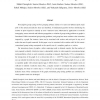Free Online Productivity Tools
i2Speak
i2Symbol
i2OCR
iTex2Img
iWeb2Print
iWeb2Shot
i2Type
iPdf2Split
iPdf2Merge
i2Bopomofo
i2Arabic
i2Style
i2Image
i2PDF
iLatex2Rtf
Sci2ools
CORR
2010
Springer
2010
Springer
Graph-Constrained Group Testing
Non-adaptive group testing involves grouping arbitrary subsets of n items into different pools. Each pool is then tested and defective items are identified. A fundamental question involves minimizing the number of pools required to identify at most d defective items. Motivated by applications in network tomography, sensor networks and infection propagation, a variation of group testing problems on graphs is formulated. Unlike conventional group testing problems, each group here must conform to the constraints imposed by a graph. For instance, items can be associated with vertices and each pool is any set of nodes that must be path connected. In this paper, a test is associated with a random walk. In this context, conventional group testing corresponds to the special case of a complete graph on n vertices. For interesting classes of graphs a rather surprising result is obtained, namely, that the number of tests required to identify d defective items is substantially similar to what req...
Conventional Group | CORR 2010 | Defective Items | Education | Group |
| Added | 09 Dec 2010 |
| Updated | 09 Dec 2010 |
| Type | Journal |
| Year | 2010 |
| Where | CORR |
| Authors | Mahdi Cheraghchi, Amin Karbasi, Soheil Mohajer, Venkatesh Saligrama |
Comments (0)

